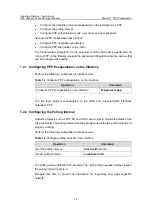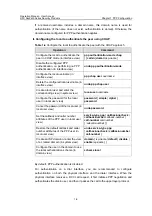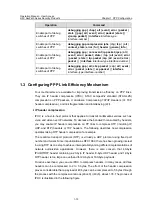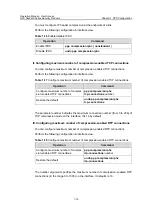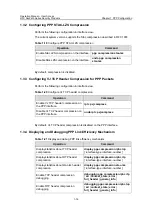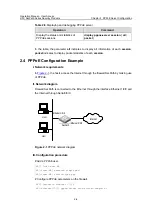
Operation Manual – User Access
H3C SecPath Series Security Products
Chapter 1 PPP Configuration
1-13
Operation
Command
Enable part of debug
switches of PPP
debugging ppp { chap { all | event | error | packet |
state }| pap { all | event | error | packet | state }|
vjcomp packet }
[
interface
interface-type
interface-number
]
Enable part of debug
switches of PPP
debugging ppp compression iphc
{
rtp
|
tcp
}
{
all
|
context_state
|
error
|
full_header
|
general_info
}
Enable part of debug
switches of PPP
debugging ppp
{
core event
|
ip packet
|
ipcp
{
all
|
event
|
error
|
packet
|
state
}
|
lcp
{
all
|
event
|
error
|
packet
|
state
}
|
lqc packet
|
mp
{
all
|
event
|
error
|
packet
}
} [
interface
interface-type
interface-number
]
Enable part of debug
switches of PPP
debugging ppp
{
all
|
cbcp packet
|
ccp
{
all
|
event
|
error
|
packet
|
state
}
|
scp packet
} [
interface
interface-type
interface-number
]
1.3 Configuring PPP Link Efficiency Mechanism
Four mechanisms are available for improving transmission efficiency on PPP links.
They are IP header compression (IPHC), STAC Lempel-Ziv standard (STAC-LZS)
compression on PPP packets, V. Jacobson Compressing TCP/IP Headers (VJ TCP
header compression), and link fragmentation and interleaving (LFI).
I. IP header compression
IPHC is a host-to-host protocol that applies to transmit multimedia services such as
voice and video over IP networks. To decrease the bandwidth consumed by headers,
you may enable IP header compression on PP links to compress RTP (including IP,
UDP, and RTP) headers or TCP headers. The following describes how compression
operates taking RTP header compression for example.
The real-time transport protocol (RTP) is virtually a UDP protocol using fixed port
number and format. Since its publication as RFC 1889, there has been growing interest
in using RTP as one step to achieve interoperability among different implementations of
network audio/video applications. However, there is also concern that 40-byte
IP/UDP/RTP header containing a 20-byte IP header, 8-byte UDP header and 12-byte
RTP header, is too large an overhead for 20-byte or 160-byte payloads.
To reduce overhead, you can use IPHC to compress headers. In many cases, all three
headers can be compressed to 2 to 5 bytes. The effect of the header compression
proves considerable that a payload of 40 bytes can be compressed to 5 bytes through
the process with the compression ratio as (40+40) / (40+5), about 1.78. The process of
IPHC is illustrated in the following figure.





